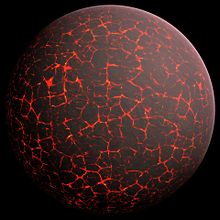Hadean and Archean eons
Main articles: Hadean and Archean
Artist's conception of Hadean EonEarth, when it was much hotter and inhospitable to all forms of life.
The first eon in Earth's history, the Hadean, begins with the Earth's formation and is followed by the Archean eon at 3.8 Ga.:145 The oldest rocks found on Earth date to about 4.0 Ga, and the oldest detrital zirconcrystals in rocks to about 4.4 Ga,soon after the formation of the Earth's crust and the Earth itself. The giant impact hypothesis for the Moon's formation states that shortly after formation of an initial crust, the proto-Earth was impacted by a smaller protoplanet, which ejected part of the mantle and crust into space and created the Moon.
From crater counts on other celestial bodies, it is inferred that a period of intense meteorite impacts, called the Late Heavy Bombardment, began about 4.1 Ga, and concluded around 3.8 Ga, at the end of the Hadean. In addition, volcanism was severe due to the large heat flow and geothermal gradient.Nevertheless, detrital zircon crystals dated to 4.4 Ga show evidence of having undergone contact with liquid water, suggesting that the Earth already had oceans or seas at that time.
By the beginning of the Archean, the Earth had cooled significantly. Present life forms could not have survived at Earth's surface, because the Archean atmosphere lacked oxygen hence had no ozone layer to block ultraviolet light. Nevertheless, it is believed that primordial life began to evolve by the early Archean, with candidate fossilsdated to around 3.5 Ga. Some scientists even speculate that life could have begun during the early Hadean, as far back as 4.4 Ga, surviving the possible Late Heavy Bombardment period in hydrothermal vents below the Earth's surface.





Comments
Post a Comment